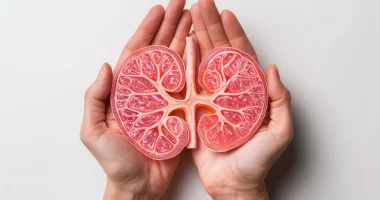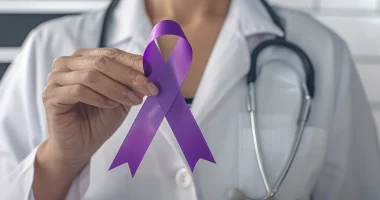Lateral collateral ligament (LCL) injury
The lateral collateral ligament (LCL) of the knee joint connects the outer epicondyle of the femur to the head of the fibula under the skin on the outer surface of the joint. Its main function is to prevent excessive inward displacement of the tibia in relation to the knee (so-called varus deformity).
Tears of the ACL are much less common than tears of the medial collateral ligament. The most likely mechanism of injury is a direct blow to the anteromedial aspect of the knee, which causes the tibia to be deflected inward and the ACL to stretch and tear. The knee joint is usually protected from such an impact by the opposite leg, but when the knee joint is flexed at the hip joint, for example, when attempting to kick a ball from the fly, the knee joint becomes unprotected from a direct blow directed from the inside to the outside. There may also be an indirect mechanism of injury when the limb is tucked during a change of direction.
After injury, there is pain on the outer surface of the knee joint and a large subcutaneous hematoma in the projection of the ligament. The patient may experience a feeling of instability. There is usually no pronounced intra-articular effusion due to the extra-articular location of the ligament. With a partial rupture, there is pain in the projection of the ligament; with a complete rupture – there is excessive deviation of the tibia. MRI allows to finally establish the nature of the tear and the presence of concomitant damage to the menisci and other ligaments of the knee joint.
The tactics of treatment of incomplete ruptures of the LCL are conservative: local cold, exclusion of load for four weeks, elevated position of the limb, elastic bandaging, and analgesics.
Surgical intervention is indicated for complete rupture of the ACL, especially in combination with damage to other structures of the posterolateral joint, cruciate ligaments, and menisci. In the case of a fresh tear, suturing of the ligament may be indicated; however, for more stable fixation, repair using autograft from the tendon of a tender muscle is more often used.
Causes of collateral ligament rupture
An isolated lateral collateral ligament tear is extremely rare due to anatomical features and other typical injury mechanics. When the lateral collateral ligament is torn, the traumatic force is so great that the so-called posterolateral complex, which includes the external collateral ligament, hamstring tendon, and posterolateral knee capsule, is injured. Although such injuries are fortunately rare, they occur among young patients in active sports, which are primarily associated with the active use of the full range of motion of the knee joint. Among such sports are game sports: soccer, basketball, and volleyball; extreme sports: alpine skiing, parachuting, parkour, cycling, and similar sports.
Rupture of the lateral collateral ligament or damage to the entire posterolateral complex cannot be overlooked. It is accompanied by a perceptible “click” or “crunch,” acute pain, and bearing capacity limitation. After a while, significant swelling of the entire area of the injured knee joint is present.
Treatment of the lateral ligament of the knee joint
First aid should be rendered immediately, and it will consist of strict limitation of load, elevated position of the injured lower limb, cooling of the injury site, and rapid transportation of the victim to a specialized medical facility. Traumatologist-orthopedist, having examined the injured knee joint, will prescribe X-rays, and if the fracture of the lateral condyle of the tibia is not confirmed, it will be recommended to perform an MRI study of the knee joint. The quality and speed of diagnosis largely determine the favorable outcome of treatment. A competent doctor with considerable experience should perform examinations and consultations on treatment tactics because isolated injuries of the lateral complex are relatively rare, and it is necessary to carefully evaluate all structures of the knee joint for their combined damage.
Treatment tactics are determined based on the number of damaged structures in the knee joint. A tear of the lateralcollateral ligament cannot be treated without surgical intervention, unlike, for example, a tear of the medial collateral ligament. This is due to the lateral collateral ligament’s distance from the soft tissues of the joint and its greater isolation.
Surgery for collateral ligament injury
When planning surgery, collateral damage to the knee joint must be considered. Most often, an arthroscopic knee revision is required to suture or remove a damaged meniscus, repair the anterior or posterior cruciate ligament, or visualize a hamstring tendon injury.
After performing all the necessary intra-articular manipulations, a competent orthopedic trauma surgeon begins to restore (repair) the lateral collateral ligament of the knee joint. It is performed using autograft (the patient’s tendons) to replace the damaged ligament. The autograft is prepared in a special way and guided through the bone canals. This ensures that the anatomy is replicated and the function of the knee joint is restored. Of course, in the postoperative period, it is impossible to ignore the importance of rehabilitation therapy to restore a full range of motion and adequate muscle tone. After the end of the recovery period, the patient can return to the usual sports activities virtually without restrictions. In modern surgery, biocompatible and biodegradable fixators are used, which improves the quality of the subsequent MRI study and the quality of diagnosis (even modern metal fixators, despite the possibility of performing MRI studies with them, give very strong interference with the magnetic signal of the tomograph).
Conservative treatment of the lateral and collateral ligaments of the knee
If the tear of the lateral collateral ligament is partial, conservative treatment is acceptable; however, the decision on one or another treatment tactic should be made by an experienced and knowledgeable trauma surgeon. Conservative treatment consists of immobilizing the knee joint in a comfortable straight orthosis, protecting the knee joint from unwanted movements the first time after the injury. Therapy should be recommended to reduce the likelihood of deep vein thrombosis of the lower extremities. This prevention includes wearing compression knitwear, compliance with the regime of loads and the position of the lower limb, as well as taking special antiaggregant drugs. The terms of immobilization are determined individually depending on the degree of injury, but on average, they are 4-6 weeks from the moment of injury. After a course of rehabilitation therapy, the patient can start sports in full, protecting the knee joint with a special orthosis (kneecap), which allows flexion and extension of the knee joint, protecting the external collateral ligament of the knee joint from overload.
The lateral collateral ligament is rarely damaged by tearing off its attachment site to the fibula head. In this case, it depends on the size of the bone fragment of the lateral collateral ligament attachment and the degree of displacement. Surgical treatment is recommended if the bone fragment is minor and/or its displacement is significant. Conservative treatment is acceptable if the bone fragment is large and displaced insignificantly.
It should be noted that the common peroneal nerve passes in the area of the head of the fibula, which is the distal attachment point of the lateral collateral ligament of the knee, and its importance can hardly be overestimated. It is responsible for the ability to perform dorsal flexion of the foot, without which normal walking is impossible. Therefore, the choice of surgeon in this case should be prudent.
If diagnosed correctly and quickly, and treatment is prescribed and performed by competent specialists, conservative and surgical treatment will allow the patient to return to normal physical activities after rehabilitation. Even a severe injury, such as a tear of the lateral collateral ligament, cannot be a reason to reduce the pace of life in the modern world and give up your favorite sports activities.
All these treatment options are available in more than 820 hospitals worldwide (https://doctor.global/results/diseases/lateral-collateral-ligament-lcl-injury). For example, Arthroscopic reconstruction of the knee ligament can be performed in these countries for following approximate prices:
Turkey $5.2 K in 26 clinics
China $8.7 K – 14.5 K in 8 clinics
Germany $12.9 K in 43 clinics
Israel $26.6 K in 16 clinics
United States $27.0 K in 17 clinics.


